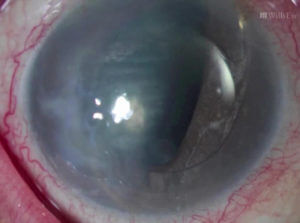Dislocated Intraocular Lens
Sometimes, the intraocular lens that was placed in the eye at the time of cataract surgery may shift position.
Call Us: 215-928-3180
Sometimes, the intraocular lens that was placed in the eye at the time of cataract surgery may shift position.
Call Us: 215-928-3180
 Sometimes, the intraocular lens that was placed in the eye at the time of cataract surgery may shift position. This is typically, but not always, due to trauma that happens after surgery. It may also occur secondary to other eye surgeries that result in movement of the initial lens. When the lens shifts, it may rub on the iris and cause inflammation. The malpositioned lens may also not provide adequate visual acuity, or may result in visual distortions.
Sometimes, the intraocular lens that was placed in the eye at the time of cataract surgery may shift position. This is typically, but not always, due to trauma that happens after surgery. It may also occur secondary to other eye surgeries that result in movement of the initial lens. When the lens shifts, it may rub on the iris and cause inflammation. The malpositioned lens may also not provide adequate visual acuity, or may result in visual distortions.
There are several options in cases of dislocated intraocular lenses. In some cases, the intraocular lens that exists can simply be repositioned. In other cases, the lens cannot be repositioned and needs to be removed entirely and replaced with a new intraocular lens.
Depending on the structures present inside the eye and whether the “bag” that was holding the original lens is intact, the surgeon may place the new intraocular lens directly into the “bag,” or may position the new lens in other parts of the eye (e.g. in front of the “bag,” a region called the sulcus; or alternatively in front of the iris). When no “bag” is present, the surgeon may fixate a lens to the wall of the eye (called the sclera) or to the iris.
Several techniques exist to fixate the lens to the eye, some involving and others without sutures. The surgeon will usually pick a technique based on his/her experience. Sometimes, the jelly from the back of the eye (the vitreous) comes forward during the surgery, and the surgeon has to remove some of it (a procedure called a vitrectomy).
